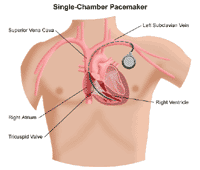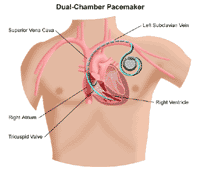Overview of Pacemakers
 Click Image to Enlarge
Click Image to EnlargeA permanent pacemaker, a small device that is implanted under the skin (most often in the shoulder area just under the collarbone), sends electrical signals to start or regulate a slow heartbeat. A permanent pacemaker may be used to make the heartbeat if the heart's natural pacemaker (the SA node) is not functioning properly and has developed an abnormally slow heart rate or rhythm, or if the electrical pathways are blocked.
A new type of pacemaker, called a biventricular pacemaker, is currently used in the treatment of heart failure. Sometimes in heart failure, the two ventricles (lower heart chambers) do not pump together in a normal manner. When this happens, less blood is pumped by the heart. A biventricular pacemaker paces both ventricles at the same time, increasing the amount of blood pumped by the heart. This type of treatment is called cardiac resynchronization therapy
 Click Image to Enlarge
Click Image to EnlargeAn implantable cardioverter defibrillator (ICD) looks very similar to a pacemaker, except that it is slightly larger. It has a generator, one or more leads, and an electrode for each lead. These components work very much like a pacemaker. However, the ICD is designed to deliver an electrical shock to the heart when the heart rate becomes dangerously fast, or “fibrillates.”
An ICD senses when the heart is beating too fast and delivers an electrical shock to convert the fast rhythm to a normal rhythm. Some devices combine a pacemaker and ICD in one unit for persons who need both functions.
The ICD has another type of treatment for certain fast rhythms called anti-tachycardia pacing (ATP). When ATP is used, a fast pacing impulse is sent to correct the rhythm. After the shock is delivered, a “back-up” pacing mode is used if needed for a short while.
When the heart's natural pacemaker has a dysfunction, the signals it sends out may become erratic: either too slow, too fast, or too irregular to stimulate adequate contractions of the heart chambers. When the heartbeat becomes erratic, it is referred to as an arrhythmia (an abnormal rhythm of the heart, which can cause the heart to pump less effectively).
Arrhythmias can cause problems with contractions of the heart chambers by:
- not allowing the chambers to fill with an adequate amount of blood because the electrical signal is causing the heart to pump too fast.
- not allowing a sufficient amount of blood to be pumped out to the body because the electrical signal is causing the heart to pump too slow or too irregularly.
 Click Image to Enlarge
Click Image to EnlargeThe heart is, in the simplest terms, a pump made up of muscle tissue. Like all pumps, the heart requires a source of energy in order to function. The heart's pumping action comes from an intrinsic electrical conduction system.
An electrical stimulus is generated by the sinus node (also called the sinoatrial node, or SA node), which is a small mass of specialized tissue located in the right atrium (right upper chamber) of the heart. The sinus node generates an electrical stimulus periodically (60-100 times per minute under normal conditions). This electrical stimulus travels down through the conduction pathways (similar to the way electricity flows through power lines from the power plant to your house) and causes the heart's lower chambers to contract and pump out blood. The right and left atria (the two upper chambers of the heart) are stimulated first and contract a short period of time before the right and left ventricles (the two lower chambers of the heart). The electrical impulse travels from the sinus node to the atrioventricular (AV) node, where impulses are slowed down for a very short period, then continues down the conduction pathway via the bundle of His into the ventricles. The bundle of His divides into right and left pathways to provide electrical stimulation to both ventricles.
Normally, as the electrical impulse moves through the heart, the heart contracts about 60 to 100 times a minute. Each contraction of the ventricles represents one heartbeat. The atria contract a fraction of a second before the ventricles so their blood empties into the ventricles before the ventricles contract.
Under some conditions, almost all heart tissue is capable of starting a heartbeat, or becoming the pacemaker. An arrhythmia occurs when:
- the heart's natural pacemaker develops an abnormal rate or rhythm
- the normal conduction pathway is interrupted
- another part of the heart takes over as pacemaker
In any of these situations, the body may not receive enough blood because the heart cannot pump out an adequate amount with each beat as a result of the arrhythmia's effects on the heart rate. The effects on the body are often the same, however, whether the heartbeat is too fast, too slow, or too irregular. Some symptoms of arrhythmias include, but are not limited to:
- weakness
- fatigue
- palpitations
- low blood pressure
- dizziness
- fainting
The symptoms of arrhythmias may resemble other medical conditions. Consult your physician for a diagnosis.
A permanent pacemaker has three components:
- a pulse generator which has a sealed lithium battery and an electronic circuitry package. The pulse generator produces the electrical signals that make the heart beat. Many pulse generators also have the capability to receive and respond to signals that are sent by the heart itself.
- one or two wires (also called leads). Leads are insulated flexible wires that conduct electrical signals to the heart from the pulse generator. The leads may also relay signals from the heart to the pulse generator. One end of the lead is attached to the pulse generator and the electrode end of the lead is positioned in the atrium (the upper chamber of the heart) or in the ventricle (the lower chamber of the heart).
- electrodes on each lead
Older pacemakers sent out electrical signals at a constant rate, regardless of the heart's own rate. Pacemaker technology is now much more advanced. Today, pacemakers can "sense" when the heart's natural rate falls below the rate that has been programmed into the pacemaker's circuitry.
Pacemaker leads may be positioned in the atrium or ventricle or both, depending on the condition requiring the pacemaker to be inserted. An atrial arrhythmia (an arrhythmia caused by a dysfunction of the sinus node or the development of another atrial pacemaker within the heart tissue that takes over the function of the sinus node) may be treated with an atrial permanent pacemaker whose lead wire is located in the atrium.
When the ventricles are not stimulated normally by the sinus node or atrial node, a ventricular pacemaker whose lead wire is located in the ventricle is placed/used. It is possible to have both atrial and ventricular arrhythmias, and there are pacemakers which have lead wires positioned in both the atrium and the ventricle.
An ICD has a lead wire that is positioned in the ventricle, as it is used primarily for fast ventricular arrhythmias.
Pacemakers that pace either the right atrium or the right ventricle are called "single-chamber" pacemakers. Pacemakers that pace both the right atrium and right ventricle of the heart and require two pacing leads are called "dual-chamber" pacemakers.
Pacemaker/ICD insertion is usually an outpatient procedure, done in the cardiac catheterization laboratory, or the electrophysiology laboratory. The patient is awake during the procedure, although sedation may be given to help the patient relax during the procedure.
Shown here is a chest x-ray. The large, white space in the middle is the heart. The dark spaces on either side are the lungs. The small object in the upper corner is an implanted pacemaker.
A small incision is made just under the collarbone. The pacemaker/ICD lead(s) is inserted into the heart through a blood vessel which runs under the collarbone. Once the lead is in place, it is tested to make sure it is in the right place and is functional. The lead is then attached to the generator, which is placed just under the skin through the incision made earlier. Once the procedure has been completed, the patient goes through a recovery period of several hours and often is allowed to go home the day of the procedure.
There are certain instructions related to having an implanted permanent pacemaker or ICD. For example, after you receive your pacemaker or ICD, you will receive an identification card from the manufacturer that includes information about your specific model of pacemaker and the serial number. You should carry this card with you at all times so that the information is always available to any healthcare professional who may have reason to examine and/or treat you.
Click here to view the
Online Resources of Heart Center
|